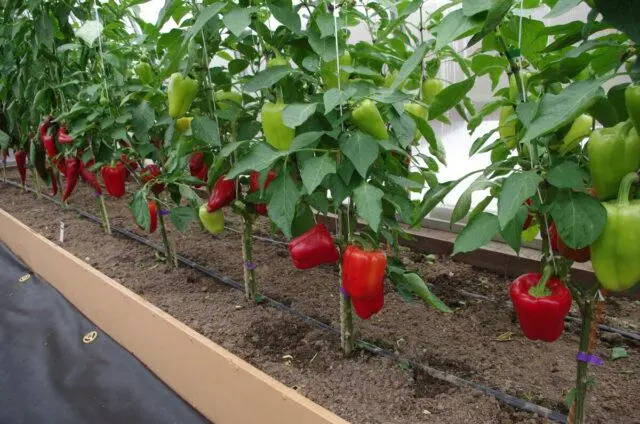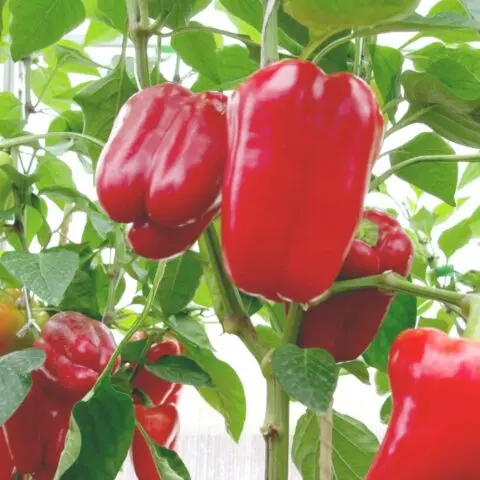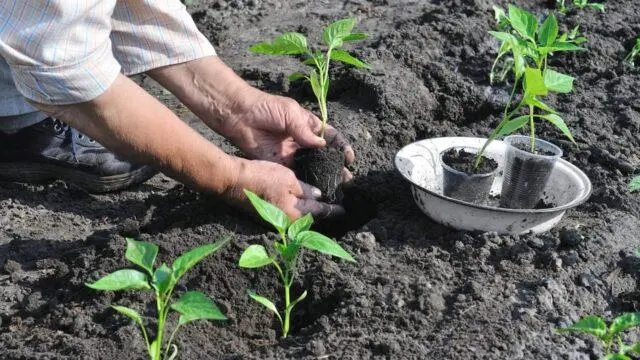Contents
Pepper Regor is a hybrid of origin that appeared on the market in 2020. Gives very beautiful fruits of red color with the correct proportions. The taste is excellent, the pulp is juicy. At the same time, the yield is very high – when grown in a greenhouse, 8 kg can be removed per square meter.
The story of
Pepper Regor was bred by the breeder Blokin-Mechtalin V.I. (he is also the originator of the variety). This is a first-generation hybrid (F1), which is included in the register of breeding achievements of the Federation in 2020. The culture adapts well to different climatic conditions, therefore it is approved for cultivation in most regions.
Description of Regor pepper
The fruits of the Regor pepper immediately catch the eye. They have the correct shape and proportions, painted in rich red. The taste is very pleasant, the pulp is juicy and aromatic.
Weight, color and shape of fruits
The fruits of the Regor pepper are drooping, in the form of a prism, the length is medium, the diameter is small. The surface is smooth, with small ribs, with a pronounced gloss. At the stage of technical ripeness, the color is greenish-white, as it ripens it becomes dark red. The taste qualities are excellent.
On a cut of a Regor pepper, two or three nests with seeds are visible. It is not worth collecting them – it will not work to grow fertile offspring, since the culture belongs to hybrids. The fruits are quite large, the average weight is 150 g. The wall thickness is from 6,5 to 7,0 mm, so peppers can be transported over long distances. Harvest transportability is good.
The height and size of the bush
The Regor pepper bush is semi-spreading, rather compact. The height is average, the plant does not take up much space. The leaves are small, the color is dark green, the surface is wrinkled.
Characteristics of Regor pepper
Pepper Regor is a high-yielding crop, and the fruits ripen in just 3,5-4 months. This allows you to harvest a crop that has reached biological ripeness already in the middle, second half of July.
Regor pepper yield
The yield of the hybrid is high – from 1 square meter it is possible to collect 7-7,4 kg. If the weather is good and the farming technique is correct, you can get up to 8,5 kg. This figure can be realistically achieved when grown in a greenhouse or under film cover. If you cultivate plants in open ground, the yield will be lower.

Pepper shows maximum yield when grown in a greenhouse
Fruiting terms
In terms of ripening, Regor pepper belongs to early ripening (early) hybrids. From the moment of appearance of mass shoots to technical ripeness, it takes from 95 to 110 days. In most regions, the fruits have time to ripen on the bushes – after a few weeks they acquire a rich red color.
Disease resistance
Pepper Regor belongs to hybrids, so its resistance to diseases is quite good. There is immunity to viral pathologies – tobacco and cucumber mosaic. However, it may suffer from late blight.
Subject to the rules of care, plants rarely suffer from pests. It is necessary to carry out preventive treatments and periodically monitor the bushes in order to stop the development of gray rot, late blight, the appearance of aphids, leafworms or other insects in time.
Growing regions
Pepper Regor tolerates night frosts and temperature changes well. Therefore, it can be grown in almost all regions, including:
- middle lane, Moscow region;
- Northwest;
- the Volga region;
- Chernozem region;
- southern regions;
- The Urals;
- Western and Eastern Siberia;
- Far East.
Advantages and disadvantages
The hybrid Regor pepper is valued for its very high yield and ability to adapt to different climatic conditions. The fruits are really tasty and quite large. They are good fresh, they are used for cooking various dishes and preservation.

The fruits are large, attractive in appearance and very tasty.
Pros:
- high yield;
- excellent taste;
- resistance to viral diseases;
- good transportability;
- the possibility of growing in different regions.
Cons:
- seeds have to be bought annually;
- high yields are achieved only in closed ground;
- medium resistance to late blight.
Peculiarities of growing
Agrotechnics for growing the Regor hybrid is standard. To get a good harvest, you need to regularly water and feed the plants. The bushes must be tied up, as the fruits grow large, and the trunk may not withstand without support.
When and how to plant seedlings
Regor pepper seeds should be planted for seedlings from February 20 to March 10. They germinate within 1-2 weeks. To speed up the process, you must first soak them in a growth stimulator and germinate on a damp cotton pad. Seeds are planted to a depth of 1-1,5 cm, preferably immediately in separate pots to avoid picking.
They are grown at a high temperature (25-27 degrees), first covered with a film and regularly moistened with a spray bottle. During the first month, they highlight, then the total time of additional illumination is reduced so that the seedlings do not stretch. Two weeks before transplanting into the ground, the seedlings are hardened by taking them to the balcony or to the street.
Transplantation in open ground
Seedlings of Regor pepper are transferred to open ground in the second half of May, when at night the temperature does not drop below 12-13 degrees. In this case, the soil should warm up to at least 15 degrees. The site is pre-cleaned, dug up and fertilized with complex mineral fertilizer (40 g per 1 m2) or compost, humus (5 kg per 1 m2). If there is a lot of clay in the soil, sawdust or sand should be embedded in it – up to 1 kg for the same area.
Regor pepper transplantation is carried out by the transshipment method – for this, the pots are watered and the earth is allowed to dry for 1-2 days. The holes are formed according to the scheme 70 * 35 cm. As a result, 1-3 plants should be placed on 4 square meter. The depth of the hole is no more than 10 cm. The roots should fit freely, and the root collar should remain flush with the soil surface. After planting, the plants are watered and mulch is laid (straw, sawdust, wood chips, peat).

Seedlings are transplanted into the ground by transshipment, without contact with the roots.
Care instructions
Regor pepper care is standard. To get a good harvest, summer residents recommend following these rules:
- Water at least once a week, in drought – every other day. Use warm, settled water. In this case, the soil should not be too wet. Excessive watering can provoke a fungal infection.
- Fertilize regularly – once every 10-15 days. Peppers are given complex mineral supplements (for example, Kemira Lux) and liquid organic matter – potassium humate, infusion of cut grass, infusion of mullein.
- After watering, loosen. If necessary, weeding is done.
- Tie bushes of Regor pepper as they grow to pre-installed supports.
- At first, seedlings should be covered from the bright sun with a white cloth.
Disease and Pest Prevention
The hybrid Regor is resistant to many diseases and pests. But prevention should not be neglected. A few days after transplanting the seedlings, they must be treated with any effective fungicide:
- “Funlazol”;
- “Maksim”;
- “Order”;
- “Score”;
- “Fitosporin”.
If you find Colorado beetles, bears, spider mites, scoops, aphids and other pests, you need to carry out several sprays with folk remedies, for example, infusion of wormwood, celandine, garlic, chili peppers. As a last resort, Regor pepper is treated with insecticides:
- “Aktara”;
- “Decis”;
- “Biotlin”;
- “Fufanon”;
- “Match” and others.
Spraying of bushes is carried out in the late evening, it is advisable to do this in dry and calm weather (when grown in open beds).

To get a good harvest, it is necessary to do preventive treatment against diseases.
Poor predecessors are tomatoes, eggplants, potatoes and other members of the Solanaceae family.
Conclusion
Regor pepper is an interesting variety that can be grown in any region. The hybrid adapts well even to adverse weather conditions, while the yield is consistently high, and the fruits themselves are very tasty.









